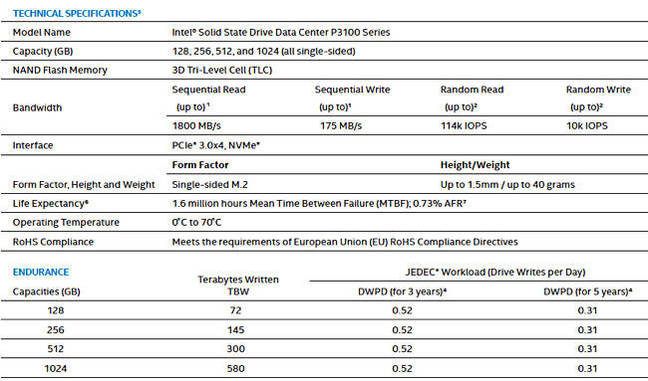This article is more than 1 year old
Intel punches out data centre flash cardlet
Chipzilla’s M.2 format SSD for data centre server reading use
Intel has released a tiny, single-sided and heavily read-optimised SSD for server use in data centres.
The P3100 is an M.2 design (22 x 80mm) built from 3D TLC (3bits/cell) NAND. This format has begun appearing in tablets, thin notebooks and desktops as it doesn't take up much space and the use of TLC (3bits/cell) NAND means capacities of up to 1TB are practical.
However, the TLC use tends to mean devices are optimised more for reading data than writing it, TLC NAND having a lower endurance than MLC (2bits/cell) flash. Typically servers are not so limited for space and 2.5in SSDs are the norm. Intel is hoping that space-constrained servers with read IOs more important than write IOs will be a viable market for its P3100 SSD.
Its random read/write IOPS are up to 114,000/10,000 and the sequential read/write bandwidth numbers are up to 1.8GBps and 175MBps. This performance profile is heavily optimised towards reading data.
It supports 0.5 drive writes per day (DWPD) for three years, 0.3 DWPD for five years, and has a five-year warranty. The product draws 10mW in its idle state, which Intel says is 90 per cent less than a typical enterprise disk drive, and averages 5.5W when active.
However, there is no power-loss data protection, although the drive does have AES-256 bit encryption.
Data centre applications for the P3100 include being a boot device, search indexing, edge caching and web hosting according to Intel.
For comparison, Intel's M.2 format 600p SSD is a client device, meaning notebook and tablet primarily, NVMe SSD with the same 3D TLC NAND media, capacity levels and 1.6 million hours MTBF rating as the P3100. Its random read/write IOPS are up to 155,000/128,000 and the sequential read/write bandwidth numbers are up to 1.8GBps and 560MBps. This has a nominally faster random read IOPS number and much, much faster random write write IOPS value; it being more balanced in its performance.
Intel's business client Pro 6000p and and IoT E 6000p are, we understand, 600p variants
The P3100 looks like a tweaked 600p.

Intel DC P3100 specs
Samsung has 960 EVO and 960 PRO M.2 client SSDs with capacities up to 1TB and using 3D NAND media (48-layer, 256Gbit 21nm TLC V-NAND). They are much faster than the P3100:
- 960 EVO
- Random read/write IOPS are up to 380,000/360,000
- Sequential read/write bandwidth numbers are up to 3.2 and 1.9GBps
- 960 PRO
- Random read/write IOPS are up to 440,000/360,000
- Sequential read/write bandwidth numbers are up to 3.5 and 2.1GBps
Micron has an 1100 SSD in both 2.5in and M.2 formats, which uses a 6Gbps SATA interface. The M.2 100's capacities are 256GB, 512GB and 1TB using 32-layer 3D NAND. (The 2.5in version goes up to 2TB.) It has a 1.5 million hours MTBF rating, which contrasts with the P3100's 1l6 million hours.
The performance numbers are:
- Random read/write IOPS are up to 92,000/83,000
- Sequential read/write bandwidth numbers are up to 530 and 500MBps
That makes it slower than the P3100 at reading but faster than writing.
When the next generation 3D NAND comes around the block from Intel (and Micron) then we should get 2TB M.2 SSD capacities and that should enable faster write IO and longer endurance in DWPD terms, both of which could endear the format more to server suppliers than this 1TB toe in the data centre water.
Download a DC P3100 product brief here (PDF). ®
